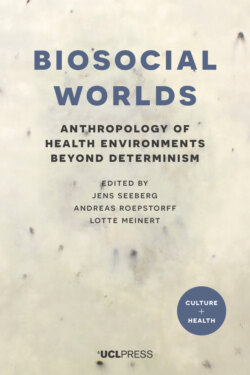Читать книгу Biosocial Worlds - Группа авторов - Страница 20
Sculpting the genome
ОглавлениеWe must now ask to what, precisely, is the genome reactive? This forces us to consider the concept of ‘environment’. Lewontin noted long ago: ‘An egg, before fertilisation, contains a complete apparatus of production deposited there in the course of its cellular development. We inherit not only genes made of DNA but an intricate structure of cellular machinery made up of proteins’ (Lewontin 2001, 143). For genes to function, they must be activated (switched on) and, when appropriate, deactivated (switched off) by means of complex processes bringing about differentiation that takes place at the cellular level throughout the life cycle.
The epigenetic mechanism best researched to date is methylation, a process uncovered in 1975 in which methyl groups are added to a DNA molecule. DNA methylation is found in all vertebrates, plants and many non-vertebrates and is highly conserved, indicating that it has long been involved with evolutionary change and developmental processes. Enzymes initiate such modifications that do not alter the actual DNA sequence, but simply attach a methyl group to residues of the nucleotide cytosine, thus rendering that portion of DNA inactive.
Epigenetic researchers are careful to point out that the identification of mechanisms that transmit signals from social environments external and internal to the body resulting in DNA methylation have yet to be fully worked out. But it is incontrovertibly demonstrated that methylation functions so that any given genome is able to code for diversely stable phenotypes. In other words, although every cell at the time of formation is ‘pluripotent’, that is, it has the potential to become any kind of mature cell, methylation brings about so-called ‘cell differentiation’ resulting in liver, neuronal cells, or skin cells, for example. Methylation also determines whether an embryo bee will become a drone or a queen bee, and many other such examples exist. Furthermore, methylation does not take place only in utero and early postpartum years, as was formerly believed, but continues throughout the life span (Meaney 2010).
An additional hypothesis that attracts environmental epigeneticists posits that DNA methylation and other related mechanisms have a second very important function, namely that these processes are not solely the result of endogenous stimuli, but are also direct responses to environmental signals external to the body that modulate patterns of cellular activity; a substantial body of research of this kind now exists (Cortessis et al. 2012; Feil and Freger 2012). In recent years, it has been recognised that such environmental exposures bring about changes to the three-dimensional chromatin fibre that compacts DNA inside cells. The idea of an epigenome as a distinct layer over and enveloping the genome is no longer acceptable. The genome and epigenome is a flexible, commingled entity, orchestrated by shape-shifting chromatin that may result in hereditable changes (Lappé and Landecker 2015). In addition, strips of DNA can be damaged, often during replication, some of which changes result in mutations that may or may not be hereditable. Epigenetic mechanisms other than methylation, such as histone modifications of various kinds, also regulate gene expression, but these are as yet poorly understood. A comprehensive Wikipedia article summarises the incredible complexity and uncertainties involved in the unfolding field of epigenetics.
In summary, it is clear that genes are ‘catalysts’ rather than ‘codes’ for development (Meloni 2014), and it is the structure of information rather than information itself that is transmitted. DNA is not changed directly by environmental exposures. Rather, whole genomes respond ceaselessly to a wide range of environments and exposures, and chromatin mediates many such responses that, in turn, modulate DNA expression. The methylation processes described above are manifest in several timescales – evolution; transgenerational inheritance; individual lifetimes; life-course transitions (including infancy, adolescence, menopause, and old age), in addition to which are seasonal change modifications. The effects of these passages of time become miniaturised in individual bodies, making them researchable at the molecular level. This was first demonstrated using rats, discussion of which is set out below following an account of the consolidation of the field of epigenetics.
